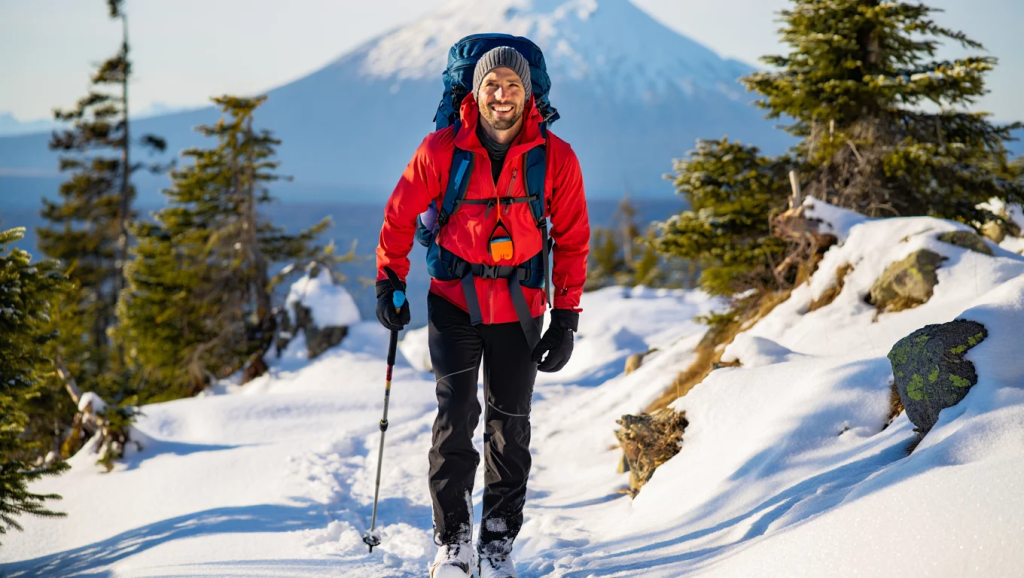Winter hiking alters familiar trails into magical wonderlands of snow and silence.
The crisp air fills your lungs as your boots crunch through fresh powder.
Have you ever noticed how sounds seem to travel differently in winter?
While summer hikers battle bugs and crowds, you’ll enjoy peaceful solitude on winter trails.
But preparation is key!
Proper clothing, navigation tools, and shorter daylight hours require careful planning.
What winter hiking experience do you have?
Are you looking to try it for the first time, or are you seeking to improve your cold-weather venture skills?
Why Go Hiking in Winter?
Winter hiking offers amazing experiences you can’t get any other season.
Snow-covered trails look like magical wonderlands, and you’ll see beautiful ice formations on rocks and trees.
The cold air feels fresh and clean, making it easier to breathe while walking.
Wildlife tracks in snow tell stories about animals that live nearby.
Winter hiking also builds mental toughness and confidence.
Plus, you’ll have most trails to yourself since fewer people hike in cold weather.
Just dress warmly in layers, bring extra gear, and let someone know your hiking plans for safety.
Essential Gear for Winter Hiking
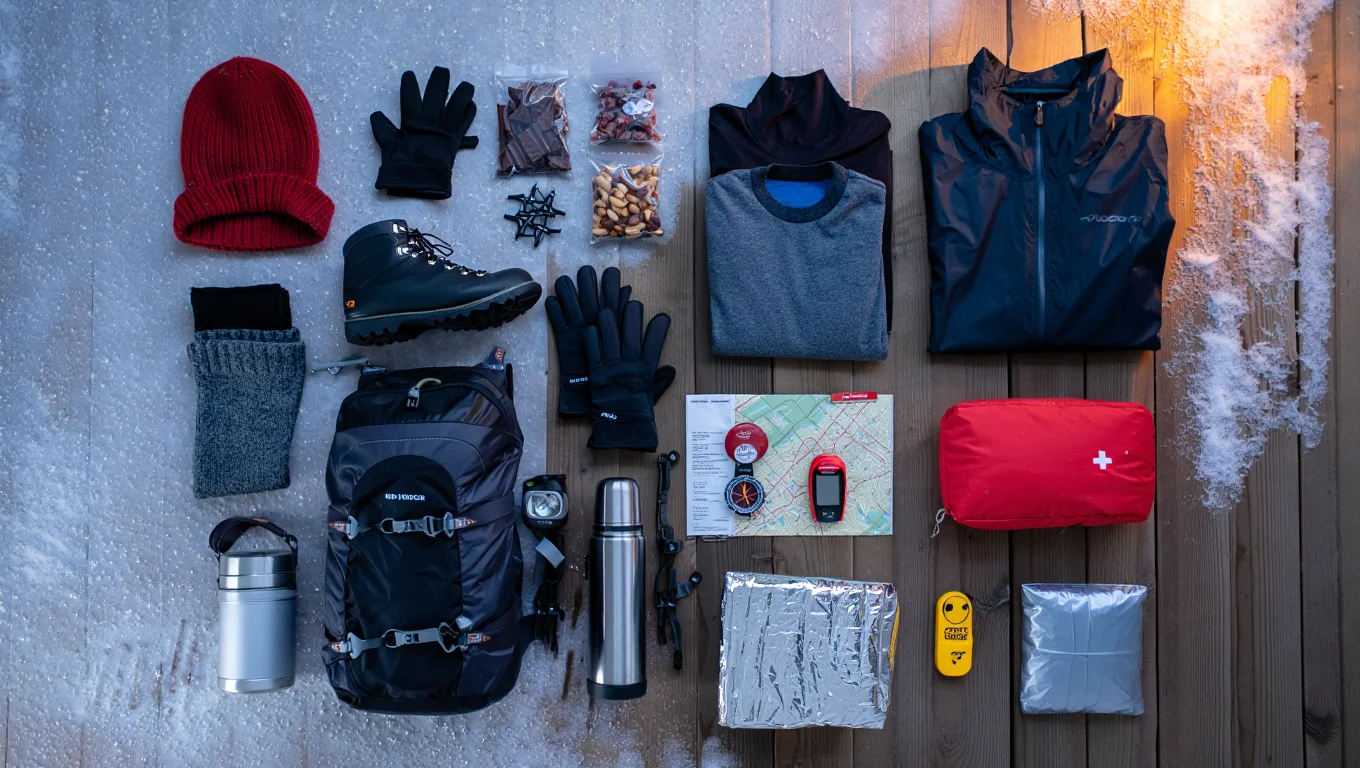
Winter hiking demands specialized equipment to ensure safety and comfort in cold, snowy conditions.
Proper gear selection can make the difference between an enjoyable experience and a potentially dangerous situation.
Clothing System
Dressing in layers is key to staying warm, dry, and comfortable during winter hikes.
| ITEM | PURPOSE |
|---|---|
| Moisture-wicking base layers | Move sweat away from skin to prevent chilling (synthetic or wool, never cotton) |
| Insulating mid-layers | Trap body heat using fleece or down materials |
| Waterproof/windproof outer shell | Block wind and moisture while allowing sweat to escape |
| Warm hat covering ears | Prevent significant heat loss through the head |
| Waterproof gloves or mittens | Protect hands from cold, wind, and moisture |
| Thick hiking socks | Provide cushioning and insulation (wool or synthetic blend) |
| Gaiters | Keep snow from entering boots and wetting socks |
| Insulated, waterproof hiking boots | Provide traction on snow/ice and keep feet dry and warm |
A well-planned clothing system keeps your body protected and performing well in harsh, cold conditions.
Navigation & Safety Equipment
Pack these must-haves to stay safe and prepared on icy, cold-weather trails.
- Microspikes or Crampons: Provide traction on icy surfaces
- Backpack (30–40 Liter Capacity): Carry layers, food, water, and emergency gear
- Insulated Water Bottle or Thermos: Prevents drinking water from freezing
- Headlamp with Extra Batteries: Travel safely during short daylight hours
- First Aid Kit with Emergency Blanket: Treat injuries and stay warm in emergencies
- Navigation Tools: Find your way through snow-covered trails (map, compass, GPS)
- High-Calorie Snacks and Meals: Support your body’s increased energy needs in cold weather with nutrient-dense, easy-to-carry foods.
Having the right navigation and safety gear ensures confidence and protection through unpredictable winter terrain.
Special Considerations for Solo Hikers

Solo winter hiking requires additional preparation and equipment to ensure your safety in remote, cold conditions.
- Personal Locator Beacon: Sends emergency signals when cell service is unavailable
- Extra Insulation Layer: Provides backup warmth if your main layers get wet
- Comprehensive Emergency Kit: Prepares you to handle emergencies far from help
- Bivvy Sack or Emergency Shelter: Offers protection from the elements if you’re stranded
- Extended Food and Water Supplies: Keeps you nourished if your hike extends unexpectedly
- Compact Stove with Fuel: Allows you to melt snow or heat food and drinks in emergencies
- Firestarter Kit (waterproof matches/lighter): Helps start a fire for warmth or signaling
- Trekking Poles with Snow Baskets: Add stability on uneven or snowy terrain
- Personal Identification and Medical Info Card: Crucial in emergencies if you’re unable to speak
Winter hiking alone demands precise planning—your gear could make all the difference.
Essential Tips for Winter Hiking
Successful winter hiking requires specialized knowledge beyond standard trail skills.
These tips will help you face cold-weather challenges safely while maximizing the enjoyment of winter’s unique beauty.
1. Start with Shorter Trails
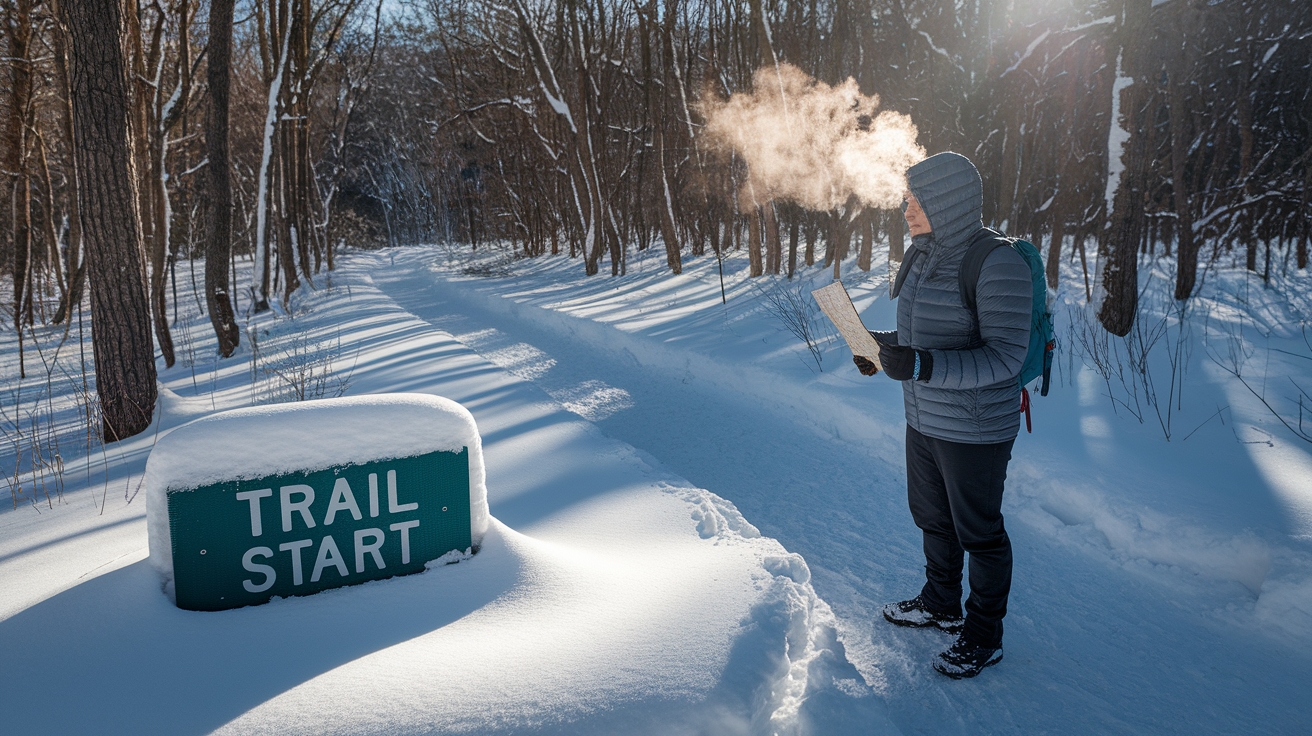
Begin with familiar, shorter trails to adjust to winter conditions.
Snow hiking requires more energy—a trail that takes two hours in summer might take three to four hours in winter.
Use these initial hikes to practice winter-specific skills in less demanding environments where mistakes have fewer consequences.
Pay attention to how your body responds to cold and exertion during these shorter outings.
2. Master Strategic Layering
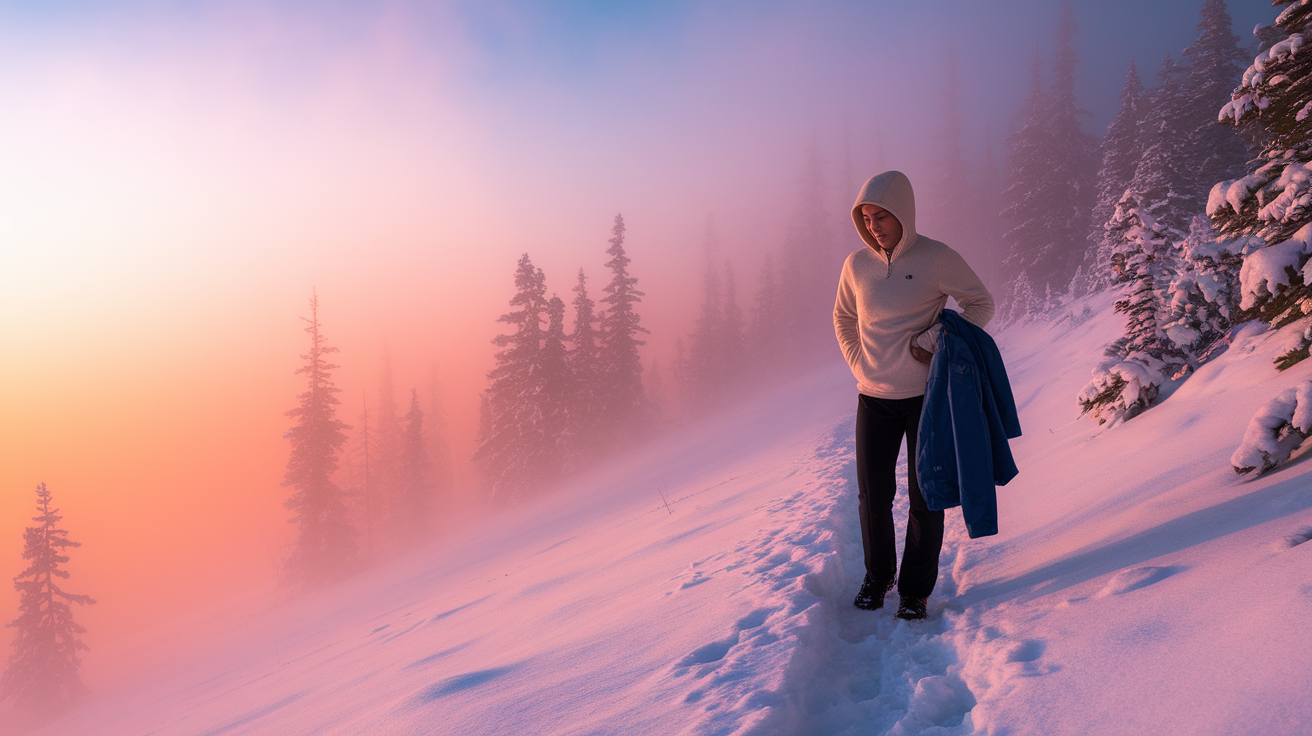
The key to winter comfort lies in proper layering.
Start with moisture-wicking base layers that move sweat away from skin.
Add insulating mid-layers for warmth, then top with waterproof/windproof shells.
This system allows you to adjust body temperature as activity levels and weather conditions change throughout the day.
Adjust layers proactively—remove before sweating and add before feeling cold.
Remember that your back, where your pack rests, will be warmer than your wind-facing front.
3. Stay Hydrated and Fueled
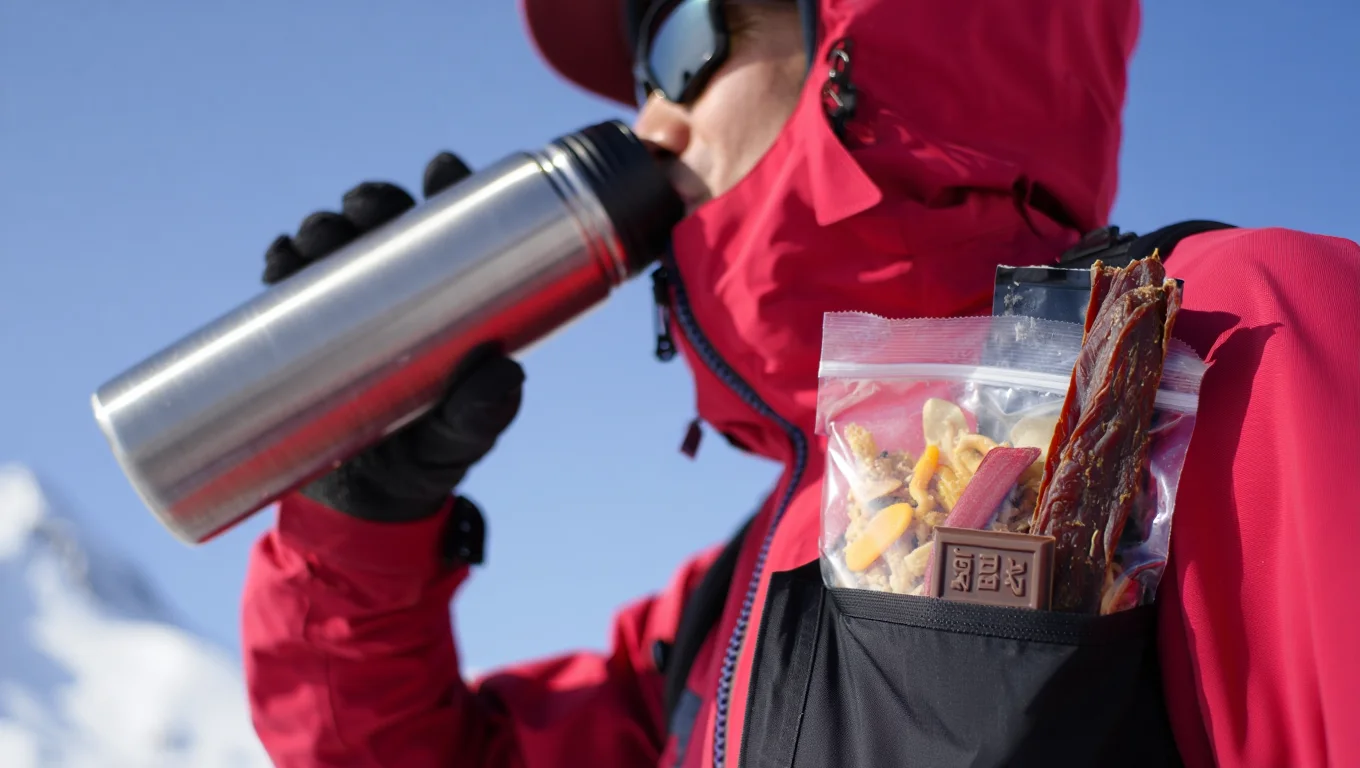
Cold weather masks thirst signals and increases calorie burn.
Drink regularly even when not feeling thirsty.
To prevent freezing, use insulated bottles, store them upside down, or keep them inside your pack near your back.
Set timers of 15-20 minutes to remain hydrated.
Pack easily accessible, high-calorie foods that won’t freeze solid, such as nuts, chocolate, cheese, and jerky.
Eat small amounts frequently rather than a few large meals to maintain consistent energy levels.
Store snacks in inner pockets to keep them from freezing.
4. Protect Your Extremities

Fingers, toes, ears, and nose are most vulnerable to frostbite.
Monitor these areas frequently and address any numbness immediately.
Carry multiple pairs of gloves and socks to replace wet ones, and consider hand/toe warmers for extremely cold conditions.
Remember that blood flow to extremities decreases when your core temperature drops, so maintaining overall warmth is essential.
Wiggle fingers and toes periodically during rest stops to increase blood flow and help prevent cold injuries.
5. Develop Snow Assessment Skills
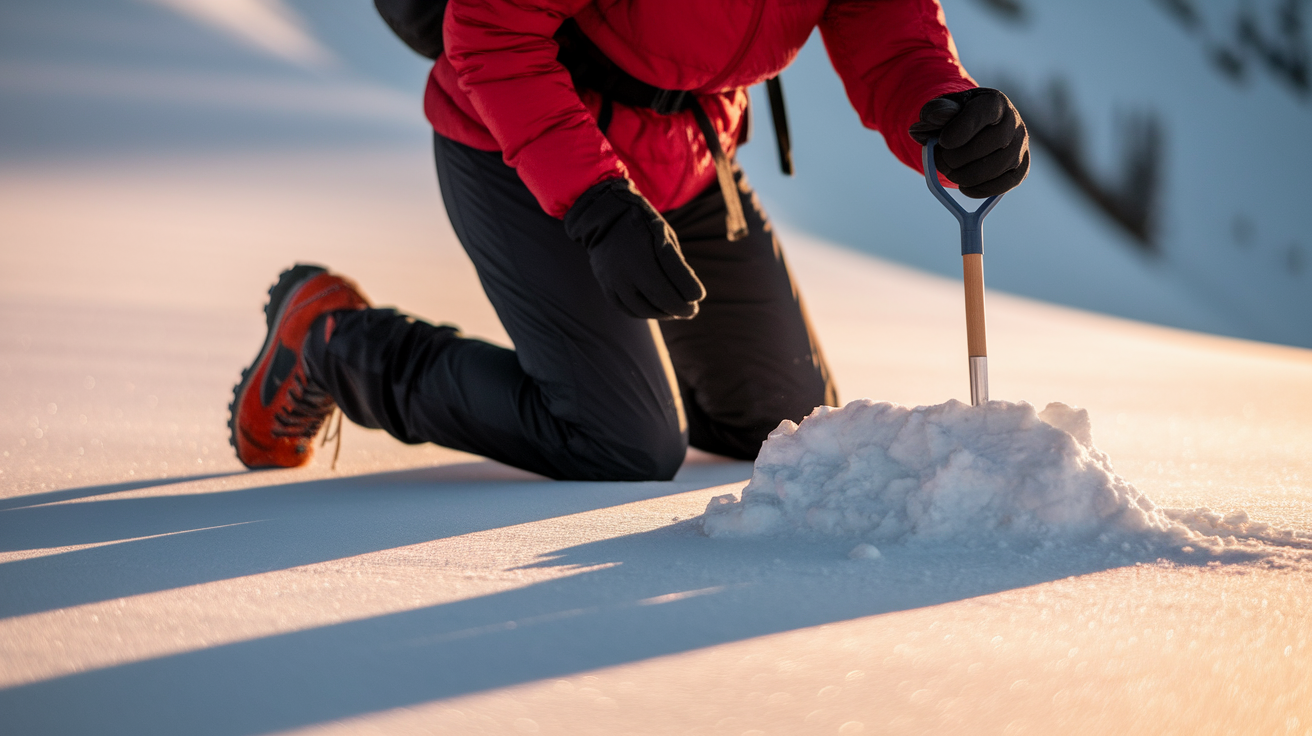
Different snow conditions affect hiking difficulty and safety.
Powder requires more energy but provides better traction.
Crusty snow may support weight or break unpredictably.
Wet snow indicates warming temperatures that can trigger avalanches in steep terrain.
Pay attention to how snow changes throughout the day as temperatures fluctuate.
Morning crust often softens by afternoon, creating deeper post-holing conditions.
Understanding snow physics and behavior dramatically improves winter hiking safety and comfort.
6. Watch Daylight Hours Carefully
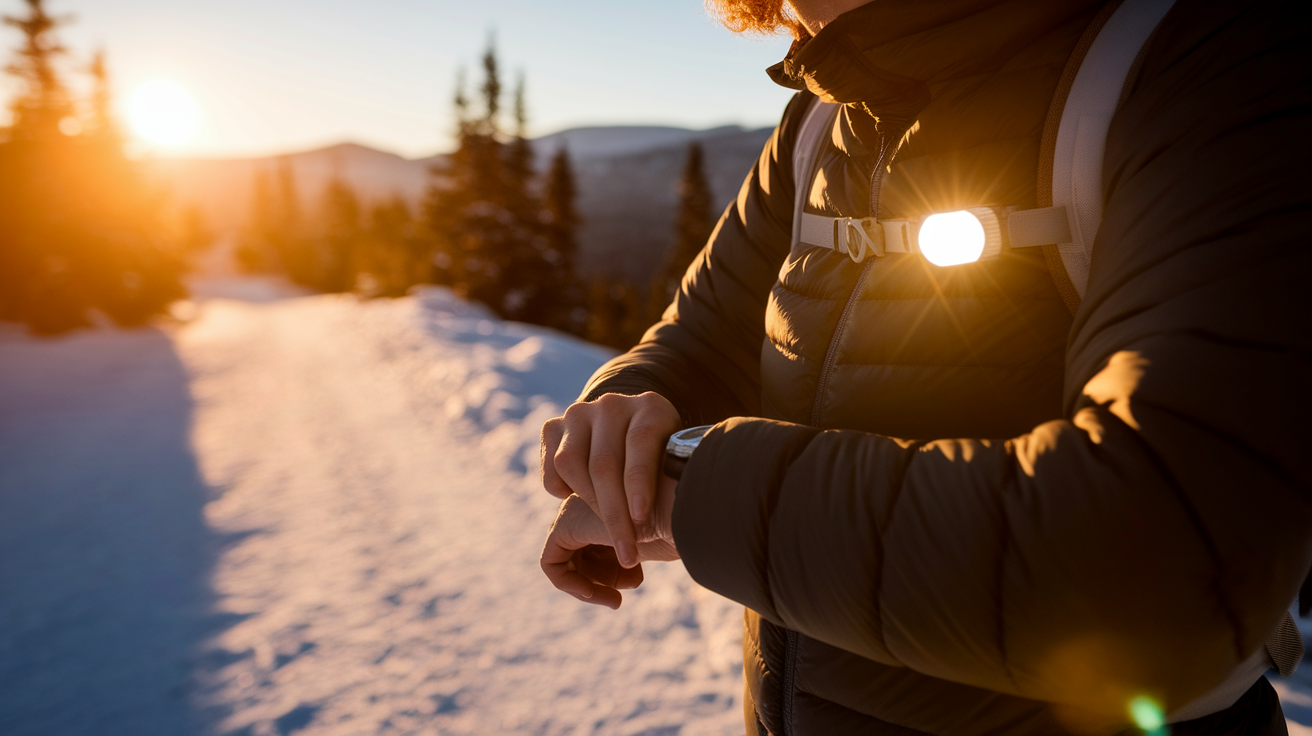
Winter days are significantly shorter.
Plan hikes to finish well before sunset, allowing buffer time for unexpected delays.
Start early and calculate turnaround times based on when daylight begins fading, not total darkness.
Always carry a headlamp with fresh batteries, even for planned day hikes.
Remember that hiking through snow in dim light conditions substantially increases injury risk, so conservative time planning is essential.
7. Practice Safe Travel Techniques
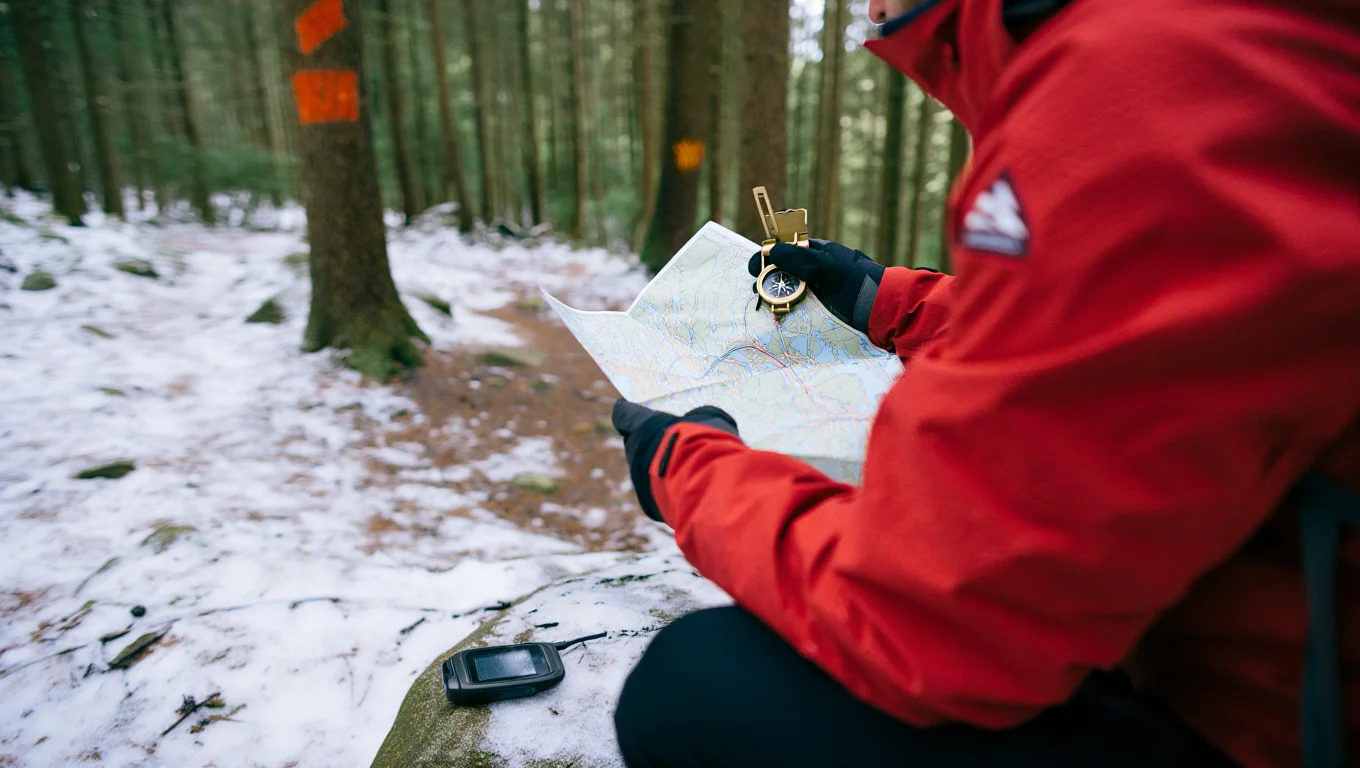
Standard trail markers may be buried under snow or difficult to spot in winter conditions.
Carry multiple navigation tools—map, compass, and GPS device with extra batteries.
Familiarize yourself with the route before starting and identify major landmarks visible in winter conditions.
Navigation errors are more serious in winter when cold compounds other problems.
Pre-downloading offline maps to your phone serves as an important backup to paper maps or dedicated GPS units.
Factors to Consider Before Winter Hiking
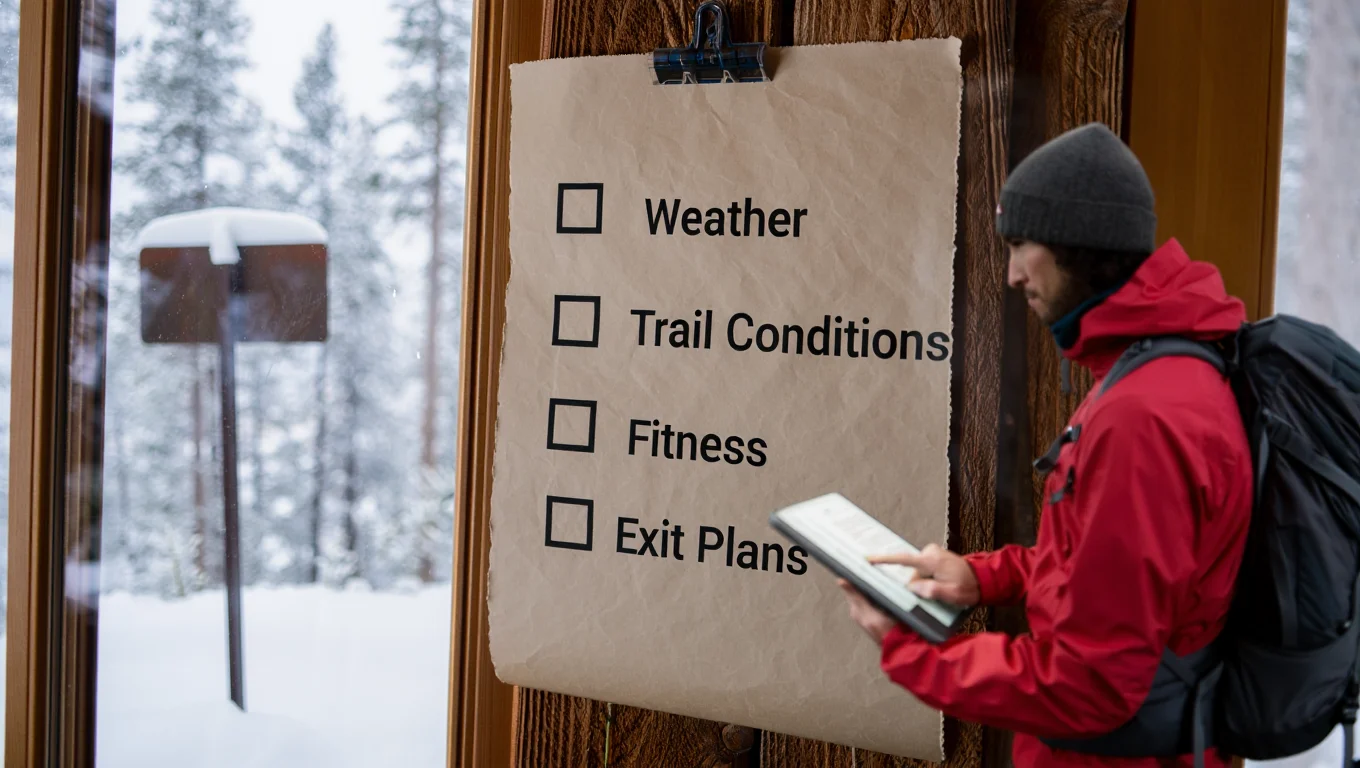
Planning ahead is essential for staying safe and comfortable on snowy trails.
Keep these key points in mind before heading out:
- Weather Forecasts: Always check for snow, wind, and cold—winter weather can shift dangerously fast.
- Trail Conditions: Snow, ice, and thaw cycles affect footing. Look for updated trail reports when possible.
- Daylight Availability: Winter days are short. Start early and finish before sunset to stay safe.
- Physical Fitness: Cold hikes are harder. Layer up, move steadily, and expect a tougher workout.
- Emergency Exit Routes: Know backup routes in case conditions worsen—never rely on one path.
- Communication Possibilities: Cell service may fail. Bring a GPS or personal beacon for safety.
Smart planning helps turn a winter hike into a safe and enjoyable trip.
Cold-Related Injuries and Prevention
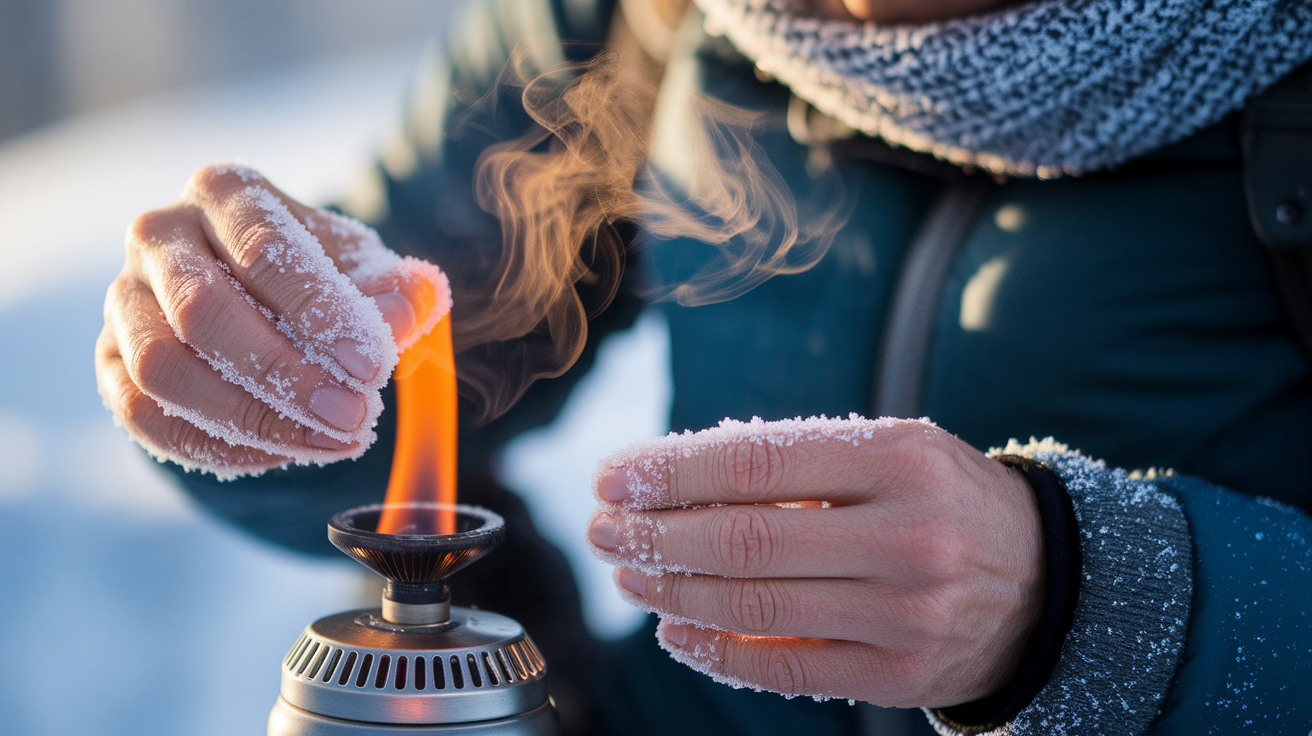
Winter hiking offers stunning views but can also expose you to serious cold-related injuries.
Understanding the symptoms and prevention tips is essential for a safe experience.
| INJURY | SYMPTOMS | PREVENTION & TREATMENT |
|---|---|---|
| Hypothermia | Shivering, slurred speech, confusion | Stay dry, wear layers, seek shelter promptly |
| Frostbite | Numbness, waxy or pale skin (especially fingers, toes, ears) | Keep extremities covered; rewarm gradually and avoid direct heat |
| Dehydration | Dry mouth, dark urine, dizziness | Drink warm fluids; use insulated bottles to prevent freezing |
| Snow Blindness | Eye pain, redness, blurred vision | Wear UV-protective sunglasses or snow goggles in sunny/snowy conditions |
Note: Being well-equipped and recognizing early signs can make the difference between a memorable hike and a medical emergency. Stay vigilant and hike smart.
Emergency Procedures
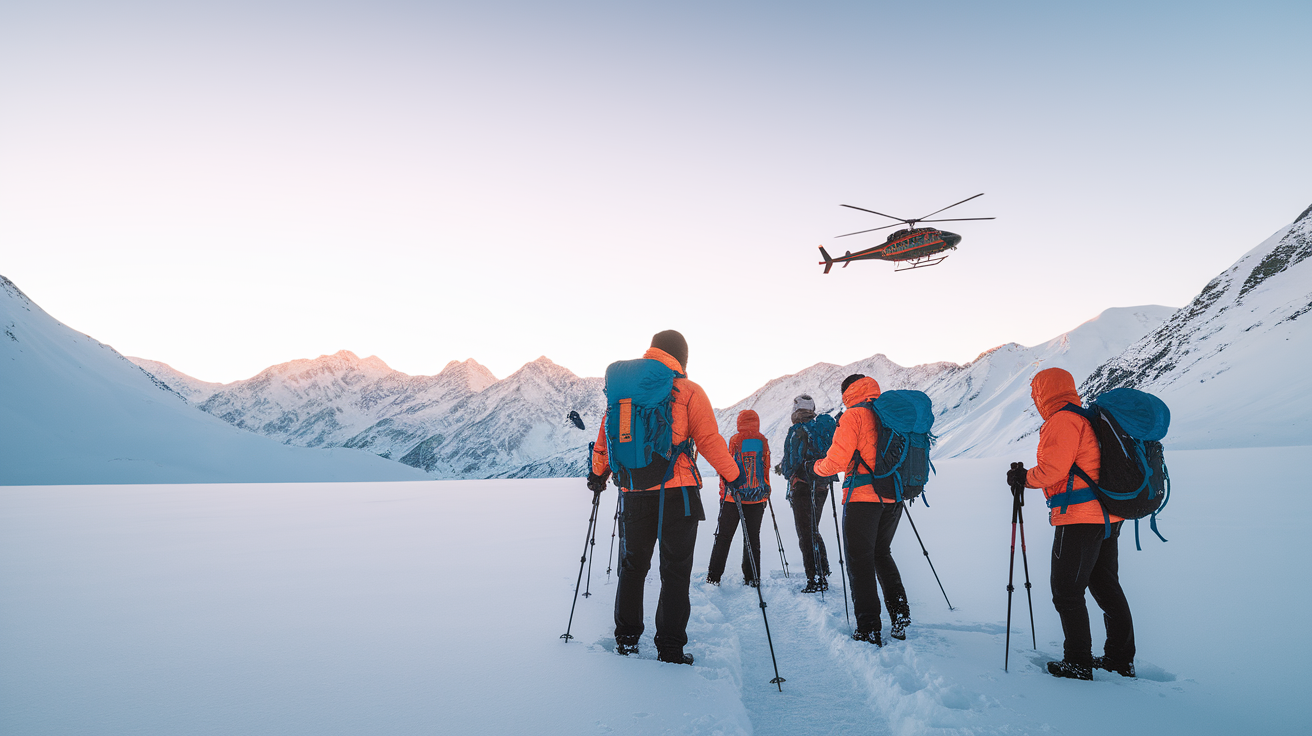
Winter emergencies can occur quickly and become deadly in cold conditions.
Being prepared with the right plan and gear can save your life or the life of someone else.
- Pick a Leader & Plan Ahead: Choose someone with first aid skills to make decisions. Solo hikers must share detailed trip plans with trusted contacts.
- Pack Smart Communication: Carry multiple devices: cell phones, satellite messengers, or personal locator beacons for backup when cell service fails.
- Signal for Rescue: Use bright gear in an X-shape on snow for air rescuers, and carry mirrors and whistles to attract attention from ground teams.
- Never Go Alone for Help – Always send pairs, never solo rescuers. Carry emergency contact info and medical details for your entire group.
- Act Fast – Spot problems early before they become dangerous. Cold weather can quickly turn small issues into life-threatening emergencies.
NOTE: Practice these emergency steps before your hike so you can act without thinking when stress levels are high.
Final Thoughts
Winter hiking opens up a whole new world of outdoor adventure that most people miss.
You’ll find quiet trails, stunning snowy views, and build confidence that lasts all year.
The key is being smart about safety, dressing right, and going prepared. Don’t let cold weather keep you inside when nature’s winter show is waiting.
Start with easy trails close to home, bring a buddy, and pack the right gear.
Share your winter hiking plans in the comments below and inspire others!

